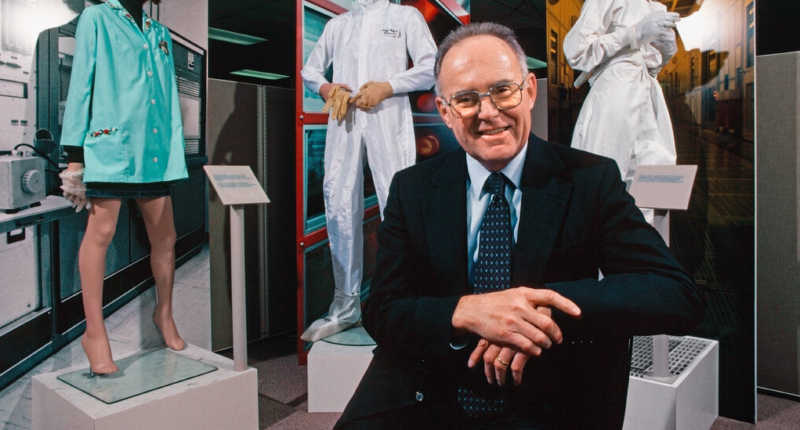Gordon Moore, the co-founder of Intel and creator of Moore’s Law, passed away at the age of 92. In the mid-1980s, with its silicon microprocessors, Intel helped American manufacturers regain the lead in computer data-processing from their Japanese competitors. By the ’90s, Intel had placed its microprocessors in 80% of the computers being made globally, becoming the most successful semiconductor company in history. Much of this happened during Moore’s tenure as chief executive, and later, chairman.
In addition to his role at Intel, Moore was a philanthropist, and he and his wife created the Gordon and Betty Moore Foundation in 2001, which has given away more than $5 billion since its founding. In interviews, Moore was humble about his achievements, particularly the technical advances that Moore’s Law made possible.
Moore’s Law predicted that the number of transistors that could be placed on a silicon chip would double at regular intervals, leading to the development of more complex silicon microchips at a lower cost. Although the miniaturization pace has slowed, it is bound to reach its end as engineers encounter some basic physical limits and extreme costs to achieve the next level of miniaturization.
Gordon E. Moore, Co-Founder of Intel and Moore’s Law Pioneer, Passes Away at 94.
Gordon E. Moore, one of the co-founders of Intel Corporation, a semiconductor chip maker based in California, passed away on Friday at the age of 94 in his Hawaii home. His demise was announced by Intel and the Gordon and Betty Moore Foundation, which he established with his wife. The cause of death was not specified.
Along with a small group of colleagues, Moore’s contributions revolutionized the technology industry. They introduced laptop computers to millions of people and integrated microprocessors into various household appliances and industrial equipment, including toasters, bathroom scales, jet planes, and cars.
Moore became a billionaire by chance after making an initial investment of $500 in the microchip industry, which grew into one of the world’s largest industries. Despite having a teaching background, he called himself an “accidental entrepreneur.”
Moore’s foresight and technical expertise helped establish Moore’s Law in 1965, which predicted that the number of transistors that could be placed on a silicon chip would double at regular intervals for the foreseeable future, leading to an exponential increase in the data-processing power of computers. Moore added two more corollaries to his theory, stating that technology would make computers more expensive to produce, but consumers would be charged less for them due to high sales volumes. His predictions held true for decades.
Moore and his colleague Robert Noyce, who was also an Intel co-founder, gathered some of the most inventive and daring technicians of the high-tech era. They advocated for the usage of silicon chips, a readily available and cheap natural resource with incredible capacity for housing increasingly smaller electronic circuitry capable of working at faster speeds.
Gordon E. Moore’s visionary insights and contributions have played a significant role in shaping the world we live in today. He will be missed.
Gordon E. Moore: The Father of Moore’s Law and Intel’s Success
Gordon E. Moore, the co-founder of Intel Corporation and the father of Moore’s Law, passed away at the age of 94 in his Hawaii home. Mr. Moore’s pioneering work with silicon microprocessors led to the exponential growth of computer processing power, enabling technology firms to make significant advancements and drive the industry forward.
During his tenure as Intel’s chief executive from 1975 to 1987, and later as the chairman until 1997, Moore was instrumental in establishing Intel’s dominance in the semiconductor industry. By the 1990s, Intel’s microprocessors were in 80% of the world’s computers, making it the most successful semiconductor company in history.
Moore’s legacy extended far beyond Intel. In 2001, he and his wife, Betty, established the Gordon and Betty Moore Foundation, which has donated over $5 billion to various philanthropic causes since its inception. The foundation’s current assets exceed $8 billion.
Moore’s Law, first proposed by Mr. Moore in 1965, predicted that the number of transistors on a silicon chip would double at regular intervals, resulting in exponential increases in processing power. The theory proved to be remarkably accurate and reliable, leading technology firms to base their product strategies around its assumptions. Today, Moore’s Law remains a guiding principle for the technology industry.
Mr. Moore, in interviews, always remained humble about his achievements and the technical advances that Moore’s Law made possible. He predicted that semiconductor devices would become the cheapest way to produce electronics, a forecast that turned out to be more precise than he ever imagined.
Mr. Moore’s contributions to the semiconductor industry and the technology sector have left an indelible mark on the world. His legacy lives on through Moore’s Law, Intel’s success, and the Gordon and Betty Moore Foundation’s philanthropic efforts.
Gordon Earl Moore was born in San Francisco in 1929 and grew up in Pescadero, a small coastal town south of the city. He studied chemistry at the University of California, Berkeley, and later received his doctorate from the California Institute of Technology (Caltech).
Mr. Moore is survived by his wife, Betty; their two sons, Kenneth and Steven; and several grandchildren. He will be missed by his colleagues, friends, and the technology community at large.
The Early Years and Entrepreneurial Ventures of Gordon E. Moore
Gordon E. Moore, the co-founder of Intel and the visionary behind Moore’s Law, was a pioneering figure in the semiconductor industry. But before he became an entrepreneur and technologist, Mr. Moore faced a number of challenges.
After being rejected for a management job at Dow Chemical due to doubts about his managerial abilities, Mr. Moore took a position at the Applied Physics Laboratory at Johns Hopkins University. He then interviewed at Lawrence Livermore Laboratory but declined the job offer due to moral objections to working with nuclear bombs. In 1956, he joined William Shockley’s team at a West Coast division of Bell Laboratories, where he began working on the development of a cheap silicon transistor.
Mr. Moore and Robert Noyce, another defector from Shockley Semiconductor, eventually formed the Fairchild Semiconductor Corporation in 1957, which became a pioneer in manufacturing integrated circuits. They later went on to co-found Intel in 1968, initially focusing on semiconductor memory.
Despite a lack of clarity in their business plan, Mr. Moore and Mr. Noyce were able to secure $2.5 million in capital and build a successful start-up. They settled on a new version of MOS technology called silicon-gate MOS, which allowed for the interconnection of multiple transistors on a single piece of silicon, creating an integrated circuit.
Intel’s 4000 series “computer on a chip” in the early 1970s marked the beginning of the personal computer revolution. However, Mr. Moore admitted that Intel missed an opportunity to manufacture a PC, a decision he partly blamed on his own shortsightedness.
Despite these challenges, Mr. Moore’s contributions to the technology industry and the semiconductor field are unparalleled. His prediction in 1965 that the number of transistors on a silicon chip would double at regular intervals, known as Moore’s Law, paved the way for exponential increases in processing power and established a guiding principle for the technology industry.
Through his brilliance, leadership, and entrepreneurial spirit, Mr. Moore played a significant role in the establishment and dominance of Intel, and his philanthropic efforts through the Gordon and Betty Moore Foundation have had a far-reaching impact.
Gordon Moore, the co-founder of Intel, was a pioneer in the world of semiconductors, and his groundbreaking predictions about computer technology were the driving force behind the industry’s growth for decades. Moore’s Law, as it came to be known, predicted that the number of transistors on a microchip would double every two years, a trend that has held true since the 1960s.
Despite facing rejection for a managerial role at Dow Chemical, Moore worked at various research facilities before joining William Shockley, a co-inventor of the transistor. When Shockley Semiconductor failed, Moore and Robert Noyce joined a group of defectors to form Fairchild Semiconductor Corporation. Moore later co-founded Intel with Noyce and Andy Grove in 1968, with a focus on semiconductor memory.
Intel’s 4000 series “computer on a chip” revolutionized personal computing in the early 1970s. Moore’s foresight made him one of the most successful semiconductor businessmen in history, and Intel placed its microprocessors in 80 percent of computers made worldwide by the 1990s.
Moore’s influence was not limited to the technological realm. He became a major philanthropist and, with his wife, founded the Gordon and Betty Moore Foundation in 2001. The foundation has given away over $5 billion since its inception, and its assets exceed $8 billion.
Moore was a modest man who shunned the trappings of wealth. Although Forbes estimated his net worth at $7 billion in 2014, he favored tattered shirts and khakis over tailored suits and shopped at Costco. He remained humble about his achievements, characteristically downplaying his prediction of the trend toward cheaper semiconductor devices.
Moore’s Law will eventually come to an end due to physical limitations and high costs, and the pace of miniaturization has slowed in recent years. Moore acknowledged this in a 2005 interview with Techworld magazine, saying that the nature of exponentials is that they eventually meet their limits. Nonetheless, Moore’s contributions to the field of semiconductors and his role in shaping the modern computer industry will be remembered for years to come.
Don’t miss interesting posts on Famousbio










